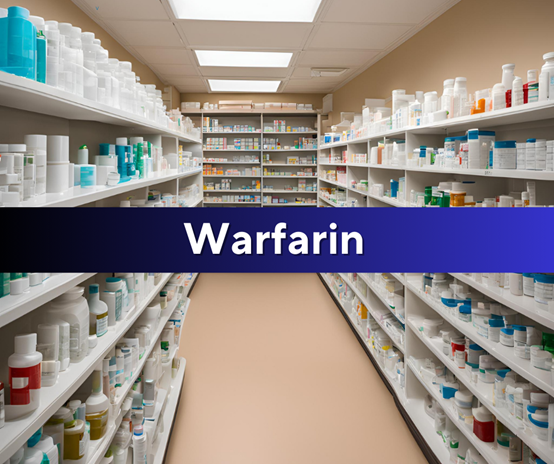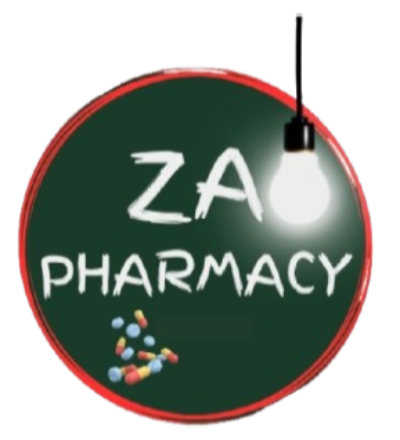Za Pharmacy
Drugs, Supplies and Delivery
Warfarin
Warfarin is an oral anticoagulant widely used to prevent and treat blood clots. It belongs to a class of drugs known as vitamin K antagonists (VKAs), which work by inhibiting the synthesis of vitamin K-dependent clotting factors. Warfarin has been a cornerstone of anticoagulation therapy for decades due to its efficacy and cost-effectiveness. However, it requires careful monitoring and dose adjustments to ensure safety and effectiveness. This article provides a detailed overview of warfarin, including its mechanism of action, uses, dosage, side effects, precautions, drug interactions, and generic names, referencing authoritative sources such as the British National Formulary (BNF), Lippincott Textbook of Pharmacology, and Lange Basic & Clinical Pharmacology.
Warfarin exerts its anticoagulant effect by interfering with the synthesis of vitamin K-dependent clotting factors. The mechanism of action involves:
- Inhibition of Vitamin K Epoxide Reductase:
- Warfarin inhibits the enzyme vitamin K epoxide reductase, which is responsible for recycling oxidized vitamin K to its reduced form.
- Reduced vitamin K is essential for the carboxylation of clotting factors II, VII, IX, and X, as well as proteins C and S.
- Reduction of Clotting Factor Activity:
- By inhibiting vitamin K recycling, warfarin reduces the functional activity of vitamin K-dependent clotting factors, leading to an anticoagulant effect.
- Delayed Onset of Action:
- Warfarin’s anticoagulant effect is delayed because it does not affect existing clotting factors but prevents the synthesis of new ones.
- The onset of action typically takes 2–3 days, and the full effect may take up to 5–7 days.
Warfarin is approved for the following conditions:
- Prevention and Treatment of Venous Thromboembolism (VTE):
- Used to prevent and treat deep vein thrombosis (DVT) and pulmonary embolism (PE).
- Prevention of Stroke and Systemic Embolism in Atrial Fibrillation:
- Used in patients with atrial fibrillation (AF) to reduce the risk of stroke and systemic embolism.
- Prevention of Thrombosis in Prosthetic Heart Valves:
- Used to prevent thromboembolic complications in patients with mechanical heart valves.
- Secondary Prevention of Myocardial Infarction (MI):
- Used in some patients post-MI to prevent recurrent thrombotic events.
The dosage of warfarin is highly individualized and requires careful monitoring of the International Normalized Ratio (INR). Below are general guidelines:
- Initial Dose:
- Adults: 5–10 mg taken orally once daily for 1–2 days.
- Elderly or Frail Patients: Lower initial doses (e.g., 2.5–5 mg) may be used to reduce the risk of over-anticoagulation.
- Maintenance Dose:
- The maintenance dose is adjusted based on the INR, which should be maintained within a target range (typically 2.0–3.0 for most indications).
- The average maintenance dose is 3–9 mg taken orally once daily.
- Monitoring:
- Regular INR monitoring is essential to ensure therapeutic anticoagulation and minimize the risk of bleeding.
- INR should be checked frequently during initiation (e.g., every 1–2 days) and less frequently once stable (e.g., every 4–6 weeks).
- Administration:
- Warfarin should be taken at the same time each day, with or without food.
- Consistency in vitamin K intake (e.g., leafy green vegetables) is important to avoid fluctuations in INR.
Warfarin is associated with several side effects, primarily related to its anticoagulant effect. These include:
- Common Side Effects:
- Bleeding (e.g., nosebleeds, gum bleeding, bruising)
- Gastrointestinal symptoms (e.g., nausea, vomiting, diarrhea)
- Less Common Side Effects:
- Hair loss
- Skin rash
- Purple toe syndrome (rare)
- Rare but Serious Side Effects:
- Major Bleeding: Gastrointestinal bleeding, intracranial hemorrhage.
- Necrosis of Skin or Tissues: Rare cases of warfarin-induced skin necrosis, typically occurring within the first few days of therapy.
Hypersensitivity Reactions: Rare cases of anaphylaxis or angioedema
- Contraindications:
- Hypersensitivity to warfarin or any component of the formulation.
- Active clinically significant bleeding.
- Severe liver disease or uncontrolled hypertension.
- Warnings:
- Bleeding Risk: Warfarin increases the risk of bleeding. Use with caution in patients with a history of bleeding disorders or conditions that predispose to bleeding.
- Pregnancy: Warfarin is teratogenic and should be avoided during pregnancy, especially during the first trimester and near term.
- Renal Impairment: Use with caution in patients with renal impairment, as warfarin is metabolized in the liver but may still require dose adjustments.
- Monitoring:
- Regular INR monitoring is essential to ensure therapeutic anticoagulation.
- Watch for signs of bleeding (e.g., unusual bruising, blood in stool or urine).
Warfarin interacts with numerous medications, foods, and supplements, making it one of the most challenging drugs to manage. Key interactions include:
- Drugs That Increase Bleeding Risk:
- Antiplatelet Agents (e.g., aspirin, clopidogrel): Increased risk of bleeding.
- NSAIDs (e.g., ibuprofen): Increased risk of gastrointestinal bleeding.
- Drugs That Affect Warfarin Metabolism:
- CYP450 Inhibitors (e.g., amiodarone, fluconazole): Increase warfarin levels, increasing the risk of bleeding.
- CYP450 Inducers (e.g., rifampin, carbamazepine): Decrease warfarin levels, reducing its efficacy.
- Foods High in Vitamin K:
- Leafy green vegetables (e.g., spinach, kale) can reduce warfarin’s anticoagulant effect. Consistency in vitamin K intake is important.
- Herbal Supplements:
- St. John’s Wort: Reduces warfarin levels.
Ginkgo biloba: Increases bleeding risk
Warfarin is available under its generic name as well as brand names. Some common formulations include:
- Generic Name: Warfarin sodium
- Brand Names: Coumadin (commonly used in the US), Marevan (commonly used in the UK), and others depending on the region.

